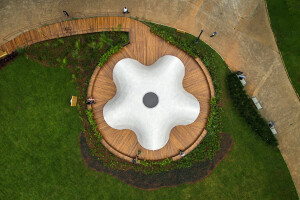MVRDV has designed a unique coral-inspired 3D printed retail facade that uses ocean plastic for the Tiffany & Co. store in Singapore Changi Airport. Highlighting the heritage brand’s commitment to sustainability (including coral conservation), the facade was created in collaboration with Amsterdam-based Aectual, a company working with circular 3D printed materials, and Milan-based engineers BUROMILAN.
When developing the design for the 3D printed facade, MVRDV picked out several distinctive design attributes that are intrinsic to Tiffany’s identity and history. These range from “touches of Tiffany Blue® to the use of innovative materials, inspired by Louis Comfort Tiffany’s contributions to the world of glass art during the late 19th century,” says the studio. (Louis Comfort Tiffany was the son of Tiffany & Co. founder Charles Lewis Tiffany and a significant contributor to the Art Nouveau style.)
Seeking a thematic anchor, MVRDV drew inspiration from Singapore’s island setting and its exceptional biodiversity, including the country’s coral reefs. Taking the variety of patterns seen in corals as a guide, the studio designed an organic, cell-like-patterned screen that would cover the facade of the Tiffany & Co. store. “This screen foregrounds a layer of glass that was screen-printed with a colour gradient [by DDG Glass], transitioning from Tiffany’s signature robin’s-egg blue to a deep blue that references Singapore’s ocean setting,” says MVRDV. (The robin’s-egg blue hue of Tiffany Blue® is a color trademarked by Tiffany — the shade was standardised by Pantone® for the brand and named “1837 Blue”, the year when the company was founded.) MVRDV’s “technology task force” at MVRDV NEXT worked on refining the coral screen pattern to ensure it could withstand different stresses.
The choice of material was a key part of the facade’s design. “Aectual developed a process to produce the 50-millimetre-thick screen using recycled plastic, including reclaimed and recycled fishing nets,” says MVRDV. The use of this type of plastic in the facade is a nod to the coral reef design. To make the facade, Aectual used a 3D printing method called Fused Granular Fabrication (FGF) that is “based on Pellet Extrusion on a robot arm.” This additive manufacturing technique deposits melted plastic granules layer-by-layer to create a solid 3D object. With the facade’s placement in an airport, meeting stringent fire regulations was a challenging task: “BUROMILAN solved the issue by adding a chemical to the mixture that is also manufactured using seawater,” says MVRDV.
The color gradient of light and dark blue can be seen in the 3D printed facade in a number of places: The screen is a light blue hue at the front of the store’s entrances and dark blue at the back; the gradient is then reversed in the corners of the facade and there is a gradual transition in-between.
Facade surface area: 142 square meters (1,528 square feet)



















































